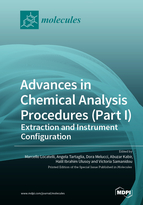Advances in Chemical Analysis Procedures (Part I): Extraction and Instrument Configuration
A special issue of Molecules (ISSN 1420-3049). This special issue belongs to the section "Analytical Chemistry".
Deadline for manuscript submissions: closed (31 December 2019) | Viewed by 46876
Special Issue Editors
Interests: innovative (micro)extraction procedures; hyphenated instrument configurations; bioactive compounds; characterization; fingerprints; method validation; HPLC; mass spectrometry; biological matrices; chromatography; analytical chemistry; sample preparation; green analytical methodologies
Special Issues, Collections and Topics in MDPI journals
Interests: method development; analytical and bioanalytical chemistry; method validation; hyphenated assay; HPLC
Special Issues, Collections and Topics in MDPI journals
Interests: chemometrics; environmental chemistry; forensics; food chemistry; pharmaceutics
Special Issues, Collections and Topics in MDPI journals
Interests: chromatographic stationary phases; substrate-free solid-phase extraction sorbents; molecular imprinting technology; sorbents for environmental pollution remediation; miniaturized sample preparation devices; field deployable sample preparation technology
Special Issues, Collections and Topics in MDPI journals
Interests: analytical method development; chromatography; pre-concentration and seperation methods; trace analysis; molecular and atomic spectroscopy
Special Issues, Collections and Topics in MDPI journals
Interests: analytical chemistry; sample preparation; chromatography; HPLC; method validation; method development; separation science; food analysis; bioanalysis; environmental analysis; green analytical chemistry; sorptive extraction; microextraction techniques
Special Issues, Collections and Topics in MDPI journals
Special Issue Information
Dear Colleagues,
Innovative analytical protocols are needed during all processes involved in chemical analysis, to establish the identities, properties, pureness, bioactivities, quantities, and other main features. Furthermore, modern analytical methods provide accurate information about therapeutic dosage and/or pharmacokinetics about new chemical entities (NCE). During the last few years, new techniques for chemical analysis have been developed which allow separation scientists to get all relevant information quickly and accurately even when the analysis is carried out in complex matrices (biological fluids, environmental samples, or food matrices). This Special Issue will highlight and describe the latest innovations in instruments and techniques developed for the extraction, analysis, and characterization of drugs, bioactive compounds, and pollutants in samples that until recently were difficult to analyze. Greater attention will be paid to recent developments in sample preparation and extraction techniques, with a focus on modern detection techniques, starting with one of the stalwarts of analytical chemistry laboratories, high-performance liquid chromatography (HPLC), up to more innovative instrumentation such as mass spectrometry, mostly used in biological sciences for detection and quantization of protein.
Subtopics: Analytical instrumental procedures; extraction procedures; novel technologies for analytical chemistry; isolation and clean-up procedures.
Schedule: Manuscript submission deadline: July 2019
Peer Review Due: August 2019
Revision Due: September 2019
Notification of acceptance by the Guest Editors: September 2019
Final manuscripts due: October 2019
Prof. Dr. Marcello Locatelli
Dr. Angela Tartaglia
Dr. Dora Melucci
Dr. Abuzar Kabir
Prof. Dr. Halil Ibrahim Ulusoy
Prof. Dr. Victoria Samanidou
Guest Editors
Manuscript Submission Information
Manuscripts should be submitted online at www.mdpi.com by registering and logging in to this website. Once you are registered, click here to go to the submission form. Manuscripts can be submitted until the deadline. All submissions that pass pre-check are peer-reviewed. Accepted papers will be published continuously in the journal (as soon as accepted) and will be listed together on the special issue website. Research articles, review articles as well as short communications are invited. For planned papers, a title and short abstract (about 100 words) can be sent to the Editorial Office for announcement on this website.
Submitted manuscripts should not have been published previously, nor be under consideration for publication elsewhere (except conference proceedings papers). All manuscripts are thoroughly refereed through a single-blind peer-review process. A guide for authors and other relevant information for submission of manuscripts is available on the Instructions for Authors page. Molecules is an international peer-reviewed open access semimonthly journal published by MDPI.
Please visit the Instructions for Authors page before submitting a manuscript. The Article Processing Charge (APC) for publication in this open access journal is 2700 CHF (Swiss Francs). Submitted papers should be well formatted and use good English. Authors may use MDPI's English editing service prior to publication or during author revisions.
Keywords
- Innovative techniques
- Extraction procedures
- Instrument configurations
- Complex matrices











